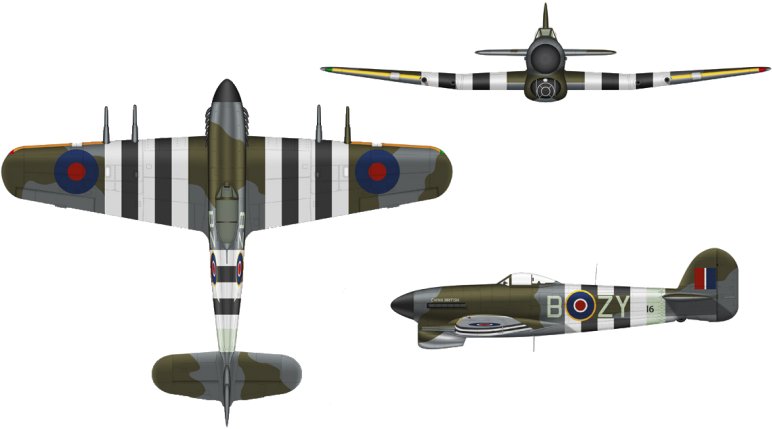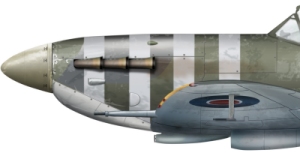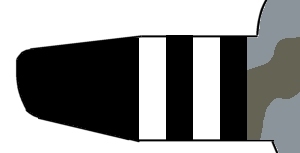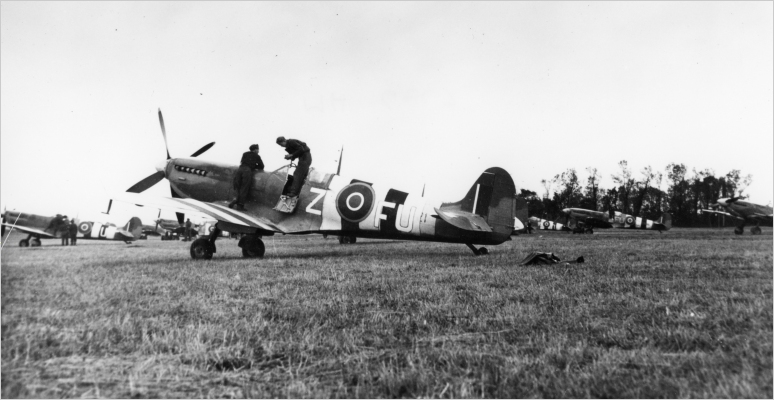Used extensively for the first time on Allied aircraft during Operation Overlord, black and white invasion stripes were designed to aid identification of friendly aircraft in the air and on the ground. This
article explains the background to these markings and some of the early ideas tested by the Allies and their use on D-Day.
During 1942 there was pressure for a second front to be opened to help take the pressure off the Soviet Union on the Eastern Front. Whilst unable to launch a full scale invasion the go ahead was given on
the 4th April 1942 for plans to be drawn up for a raid on Dieppe in Northern France. With so many aircraft involved, and the expected Luftwaffe response, the need for quick identification would be crucial.
This would see the Supermarine Spitfires taking part painted with white stripes on the front of the aircraft
to just before the cockpit and on the tail fin.
Operation Rutter, as it was known, was scheduled to take place on the 4th July 1942, at the earliest, depending on the weather. With better weather failing to materialise and with a Luftwaffe
bombing raid taking place on the raiding force, the operation was moved back on the 7th July 1942. The following month on the 19th August 1942, and now known as Operation Jubilee, the Dieppe raid took place.
The Origins of Invasion Stripes
During Operation Husky (9th July 1943 - 17th August 1943), the Allied invasion of Sicily, as part of the invasion force, Douglas Dakotas
carrying paratroopers flew in at just 400 feet over the invasion fleet, who were briefed that this airborne drop was happening. On the ground the American forces had been coming under
sustained attacks from the air and as the Dakotas passed overhead the first two formations made successful drops. Tragedy would then strike as one gunner opened fire on the aircraft, this would have
the unfortunate consequence of all shore troops and offshore ships also opening fire on the aircraft. The aftermath of this was 23 Dakotas shot down, whilst 318 soldiers were injured or killed.
With the invasion of Europe planned for June next year, codenamed Operation Overlord, but more commonly known as D-Day, a solution was needed to avoid a
repeat incident. One idea considered to solve the problem of identifying friendly or enemy aircraft was already fitted to a large number of aircraft, the friend or foe (IFF)
transponder. This would be a non-starter as due to the sheer amount of aircraft that would take part in the invasion the system would be unable to cope. In the end the solution used would be
low tech.
Operation Starkey Identification Stripes
Operation Starkey (16th August 1943 - 9th September 1943) was a fake invasion operation carried out by the Allies, with one of its aims to entice the Luftwaffe into combat in large numbers.
To aid identification of friendly aircraft two black and two white stripes were normally painted onto the lower and upper wings of the aircraft, for fighters these would measure 18 inches and for bombers 24 inches.
Some aircraft had the edge of the wing painted black, covering the Royal Air Force roundel, as well as the nose painted white.
The idea to paint, as means of identification, black and white stripes on aircraft wasn't a completely new idea as when the Hawker Typhoon
entered service on the 11th September 1941 they resembled the Focke-Wulf Fw 190 when viewed from certain
angles leading to a few 'friendly fire' incidents. This would see black and white stripes being painted under the wings only.
Invasion Stripes During Operation Overlord
Operation Overlord would see the idea expanded on and in the memorandum issued by the Supreme Headquarters Allied Expeditionary Force on the 18th April 1944, it stated that Allied aircraft taking
part in the invasion of Europe would have five stripes on both wings and on the rear fuselage without covering national markings. There were some exceptions, such as most of the four-engined heavy bombers,
night fighters and sea planes.
The size of the invasion stripes were to vary according to aircraft size, single-engined aircraft would have stripes 18 inches wide, while twin-engined aircraft would have 24 inch wide stripes. Tactical reconnaissance aircraft
which were operating at low-level were excused from painting the stripes on the top of the wing. The idea was simple and allowed gunners to make quick decisions on whether the aircraft flying over was friend or foe.

The go ahead for the idea was given on the 17th May 1944 by the Commander of the Allied Expeditionary Air Force, Air Chief Marshal Sir Trafford Leigh-Mallory. However, the order to paint the stripes
would not be given just yet, this was so the Luftwaffe would be unaware of the idea and paint them on their aircraft. To test whether the stripes added to the aircraft would work and to allow
gunners on the ships to see what they looked like, on the 1st June 1944 a few painted aircraft flew over the fleet involved in the invasion of France.
With Operation Overlord due to begin on the 5th June 1944, but delayed in the end until the 6th June 1944, security around the idea was tight, it wouldn't be until the 3rd June 1944 that the
order to paint troop carriers was given whilst other aircraft got their orders the following day.
When D-Day occurred a total of 14,574 sorties would be carried out by the Allies
and with the Luftwaffe's lack of presence over the invasion beaches and ships, as well as the invasion stripes, played a part in cutting down 'friendly fire' instances, however 127 aircraft were
lost to a number of causes. As the invasion progressed and airfields in France established the stripes on the upper parts of the aircraft were ordered to be removed a month after D-Day, although
some aircraft that took part in Operation Market Garden (17th September 1944 - 27th September 1944) still had the black and white stripes on the upper parts of the aircraft. Eventually as the
Allies progressed eastwards they would be removed from all aircraft before 1944 was over.




